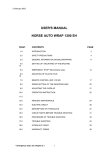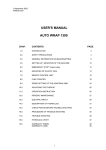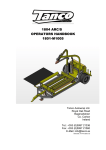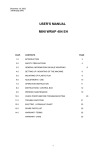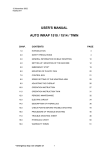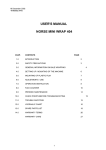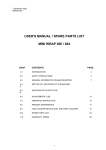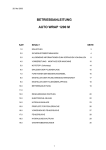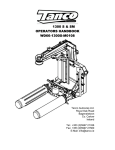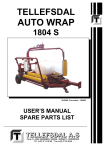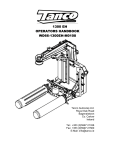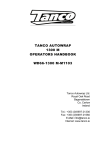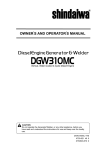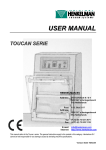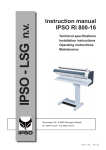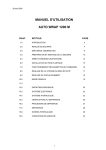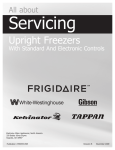Download aw_1200eh_1999_english 719KB May 04 2006 11:13:50 AM
Transcript
2 February 2003 USER'S MANUAL NORSE AUTO WRAP 1200 EH CHAP. CONTENTS PAGE 1.0 INTRODUCTION 3 2.0 SAFETY PRECAUTIONS 4 3.0 GENERAL INFORMATION ON BALEWRAPPING 8 4.0 SETTING UP / MOUNTING OF THE MACHINE 10 5.0 EMERGENCY STOP* (Momentarily stop) 14 6.0 MOUNTING OF PLASTIC FILM 15 7.0 REMOTE CONTROL UNIT, CR 900 16 8.0 SPEED SETTING OF THE WRAPPING ARM 22 9.0 ADJUSTING THE OVERLAP 23 10.0 OPERATION INSTRUCTION 24 12.0 PERIODIC MAINTENANCE 26 13.0 ELECTRIC CIRCUT 29 14.0 DESCRIPTION OF HYDRAULICS 30 15.0 CHECK POINTS BEFORE TROUBLE SHOOTING 34 16.0 PROCEDURE OF TROUBLE SHOOTING 35 17.0 TROUBLE SHOOTING 36 18.0 HYDRAULIC CHART 38 19.0 WARRANTY TERMS 39 11.0 * Emergency stop: see chapter 2.1 1 NORSE AUTO WRAP 1200 EH Bale wrapping machine 1. 2. 3. 4. 5. 6. Wrapping arm motor Wrapping arm Prestretcher Rollers Support rollers Cutter * Emergency stop: see chapter 2.1 7. 8. 9. 10. 11. 12. 2 Main frame Speed control Stationary arm Lifting sling Emergency stop* Safety guard 1.0 INTRODUCTION. TELLEFSDAL A.S congratulates you with the choice of AUTO WRAP bale wrapping machine. We are certain you will be satisfied with the machine, and that you will have the pleasure of your investment for many years. The AUTO WRAP bale wrapping machine has more features than any other bale wrapping machine available. AUTO WRAP can pick up the bale, wrap and stack them without the operator leaving the tractor cab. This system is protected by patent law's almost world wide. AUTO WRAP 1200 EH is hydraulically driven by the tractors hydraulic system, and is controlled from the tractor cab by a remote control unit. The machine can either be mounted to three point linkage, front mounted with quick-couplers to the tractors frontloader or on a wheel loader. Then it's possible to stack the bales upon each other. AUTO WRAP 1200 EH is designed to wrap bales of grass, hey or straw, with nominal diameter of 3½ - 5½ ft. (110-170cm), and weights up to 1760 lbs. (800kg). The machine is developed and has been improved since the beginning in 1986, and is now a very reliable and safe machine with high security built in. This manual is meant to explain how AUTO WRAP is prepared, mounted, used and how it works, and shall together with the spare part's list be a reference for maintenance and troubleshooting. So take good care of the books, they are a part of the machine. Read carefully through this manual, and specially chapter 2.0, safety instructions, before starting the machine, and follow the instructions thoroughly. If problems should occur, check with chapter 17.0, and try to find out what is wrong. Ask your dealer for advice before you make the problem worse than it is. See also chapter 19.0, conditions of warranty. Technical Specifications AUTO WRAP 1200 EH 2280 / 2480 mm ( 7' 6" / 8' 2") 1290 / 2880 mm ( 4' 2" / 9' 5") 2170 / 3040 mm ( 7' 1" / 10') 615 kg (1356 lbs) 22 revolutions' per minute 27 revolutions' per minute ø1700 mm ( 5' 7") 800 kg (1765 lbs) Approx. 25 bales per hour 500 mm / 750 mm (20" / 30") 1 pcs. single working, + free return 180 bar / 15 litres per minute 40 litres per minute 10 bar 12 V DC Height in working position, min. / max. Width, min. / max. Length, min. / max. Weight Wrapping arm speed, recommended Wrapping arm speed, max. Bale size, max. Bale weight, max. Capacity Prestretcher Hydraulic connection Oil pressure / amount, min. Oil amount, max. Counter pressure, max. Electric connection TELLEFSDAL A.S can change the construction and/or technical specifications without warning and without rights to changes on already delivered products. © Copyright. All rights reserved. Any copying and reproduction of this manual are not permitted without permission from TELLEFSDAL A.S. With precaution of printing failure. * Emergency stop: see chapter 2.1 3 2.0 SAFETY PRECAUTIONS. TELLEFSDAL A.S does not take the responsibility for damages that may occur on machine, persons or other equipment, because of the machine NOT being used as described in this manual, or because of the safety precautions NOT being followed. 2.1 SAFETY EQUIPMENT. Before using the machine, make sure that all guards and covers are securely fitted. The machine must not be operated if a function does not work as described later in this manual. (See chapter 2.5). * EMERGENCY STOP. Auto wrap 1200 EH is equipped with a so-called emergency stop on the wrapping arm. This device stops all functions momentarily, but is per definition not an emergency stop, because it does not shut down the inputs. But it has the same function, so we have decided to call it an emergency stop in this manual. 2.2 BECOME FAMILIAR WITH THE OPERATIONS OF THE MACHINE. If you are unsure how to operate the machine properly, either use of or maintenance to your Auto Wrap, please contact your Auto Wrap dealer. 2.3 ADJUSTMENTS' / MAINTENANCE. Turn off the tractor and discharge the oil pressure before performing any adjustment or maintenance on the machine. Remember that a well maintained machine is a safe machine. 2.4 IMPORTANT! MAKE ALWAYS SURE THAT NOBODY IS IN THE HAZARD AREA OF THE WRAPPING ARM WHEN THE MACHINE IS IN USE. THE MACHINE MUST NEVER BE OPERATED BY PERSONS WHOM DOES NOT KNOW ENOUGH ABOUT HOW TO SAFELY OPERATE THE MACHINE, OR BY PERSONS UNDER 16 YEARS OF AGE. * Emergency stop: see chapter 2.1 4 Fig. 2-2 Fig. 2-1 2.5 DANGEROUS AREAS. TELLEFSDAL A.S has given the safety to the operator the highest priority, but it is still impossible to secure oneself of every danger area on the machine. Therefore we will now go through some of the dangers that can occur when using the Auto Wrap balewrapper. 1. PUNCH OF THE WRAPPING ARM. During the wrapping process the arm rotates with a speed of 20-27 revolutions per minute around the bale. On the arm there is mounted a prestretcher unit with a plastic roll. The speed on this can give a person serious injuries if one comes to close to the working area of the wrapping arm. To reduce this danger we have mounted an emergency stop* device on the wrapping arm, this stops all movement instantly when someone comes in the way of it. It is very important that this protection always works and that it should not under any circumstances be unconnected. (See more about the emergency stop* in chapter 5.0). 2. SQUEEZE-DANGER BETWEEN THE MAIN FRAME AND THE WRAPPING ARM. As earlier explained, we have a wrapping arm with a prestretcher and a plastic roll. Once every time around this wrapping arm passes the main frame. Here there may occur a squeeze danger if a person stands to close to the main frame when the wrapping arm passes. The distance between the main frame and the wrapping arm is not large enough to give place for a person. Between the prestretcher and the bottom frame there can also be a squeeze danger. To protect the user from this there is mounted a protection guard on the right hand side of the machine. You lift this up and turn it out on the side of the machine when operating the baler. You put it in transport position by lifting it up and turning it into the frame. (Fig. 2-1). The guard must not under any circumstances be removed, and if damaged it must be repaired before the machine is used again. 3. SQUEEZE-DANGER BETWEEN THE STATIONARY AND THE WRAPPING ARM. During the main wrapping process the wrapping arm moves around a stationary arm. Every time the wrapping arm passes the stationary arm, there is a squeeze danger that can be dangerous for the fingers. The distance between the stationary and the wrapping arm is between 25-40 mm. (See fig. 2-2). * Emergency stop: see chapter 2.1 5 Fig. 2-3 Fig. 2-4 4. SQUEEZE DANGER BETWEEN THE ROLLERS AND THE MAIN FRAME. During the wrapping process the bale rotates on two rollers. These two rollers rotate around the square pipe they are mounted on. Between the roller and the square pipe there is a squeeze danger for the fingers. (See fig. 2-3). 5. SQUEEZE DANGER BETWEEN TELESCOPE FRAME AND MAIN FRAME, INWARDS. When loading a new bale, the telescope frame moves into the main frame, and this is where there can occur a squeeze danger. This is secured with a cover on the telescope frame that slides on the main frame. The machine must not be used if this cover is removed or damaged. 6. SQUEEZE DANGER BETWEEN TELESCOPE FRAME AND MAIN FRAME, OUTWARDS. On both ends of the telescope frame there can occur a squeeze danger when loading a new bale. Keep therfore hands and feet away from this area. (See fig. 2-4). 7. SQUEEZE DANGER CAUSED BY PLASTIC AUTOMATION. At the end of the wrapping process the plastic shall be perforated and held tight until the start of the next wrapping process. When the cutter arm moves down to lock the plastic, there can occur a squeeze danger between the cutter arm and the cutter holder. The cutter blade that perforates the plastic is very sharp, so keep hands away from the cutter. (See fig. 2-5). Always put the security cover over the cutter blade when the machine is not in use. * Emergency stop: see chapter 2.1 6 Fig. 2-5 Fig. 2-6 2.6 LOCKING THE WRAPPING ARM. When the machine is not in use, make sure the locking bolt for the wrapping arm is mounted, and that the secure pin is fitted. If the bolt is not mounted, the wrapping arm and/or the machine could be damaged during transport. (See fig. 2-6). 2.7 THREE POINT MOUNTING. When the machine is mounted in the three point linkage, make sure that the lifting arms are tightend up so there is no sideways movement. 2.8 FRONT MOUNTING. If the machine is mounted on the front loader there must be a counterweight in the three point linkage. It must be large enough to give the tractor good stability. Connecting heavy working implements often has an overall negative effect on the tractor's driving and braking capacity. ! 2.9 TRANSPORTING. When transported on a public road there are certain safety measures that must be taken: 1. Make sure that the locking bolt on the wrapping arm is mounted. (Chapter 2.6). 2. Lift the protection guard, turn it into the machine and secure it with the locking pin. (See chapter 2.5.2). 3. Move the main rollers completly together. 4. Always transport the machine in the lowest possible position. 5. Make sure that the machine do not cover the tractors lights. If necessary, mount extra lights. 6. Make sure that at least 20% of the tractor's total weight is on the steering wheels. 7. If the machine is front-mounted, it's necessary to balance the weight with a counterweight mounted to the three-point linkage. * Emergency stop: see chapter 2.1 7 3.0 GENERAL INFORMATION ON BALE WRAPPING. 3.1 THE PRINCIPLE. The advantages of round bale ensilage are many, and include fewer feed units, a flexible harvesting system, large capacity and the possibility of selling feed units. In principle, the same fermentation processes occur whether the fodder is placed in a silo or pressed into bales and packed in plastic, i.e. lactic acid fermentation in anaerobic conditions. The oxygen in the bale must be exhausted before fermentation begins. The grass should be dried to approximately 30-40% solid content. The solid content can be determined by twisting the grass by hand. If drops of liquid are forced out of the grass, the solid content is less than 25%. Low solid content, (wet grass), can lead to increased butyric acid fermentation if preservatives are not added to the grass. If the solid content is too high, (over 50%), normal fermentation will not take place and there will be enough oxygen in the bale to produce mould fungus. 3.2 THE BALE PRESS. It is vital that the bale press produces compact, well-formed bales, as misshapen bales can be difficult to pack. Pressing will also often take longer, thereby increasing the amount of plastic used. 3.3 DIFFICULT BALES. When a misshapen bale is packed, it will have a tendency to move outwards or inwards on the rollers. If the bale begins to move outwards, the machine must be lifted slightly at the rear edge to get the bale to rest against the support rollers on the main frame. It can therefore be useful to use a hydraulic top stay to make this adjustment easier. (See chapter 4.2). If the support rollers almost disappear into the bale the machine should be pressed down slightly at the rear edge in order to remove the bale from the machine. The plastic can be damaged when friction against the rollers increases. Best results are achieved when the bale rolls easily against the support rollers all the time. If the bale to be packed is conical you must ensure that the sharp end is pointed at the tractor. It will then be easier to get the bale to lie correctly during packing. It is easy for such a bale to "turn" forward in the direction in which it is pointing, and therefore lie against the support rollers. If the bale is lying on a slope it must be picked up from the lower side. A hydraulic top stay will again be advantageous. 3.4 TYPES OF PLASTIC. A good type of plastic with good adhesive properties, and which is recommended for bale wrapping, must be used. The thickness of the plastic foil should be at least 25 µ. (25/1,000 mm). In order that the plastic tightens sufficiently around the bale, it is stretched before being wrapped, so it is somewhat thinner when it is put on the bale. With short-term storage, (up to eight weeks), it is recommended that bales have a minimum of four layers of plastic at the thinnest points, with at least 52-53% overlap. For long-term storage, or when the grass is wet when it is packed, the bale should have 90-100 µ plastic, (6 layers), and the same amount of overlap. If thinner plastic is used, more layers should be applied. If it is very hot the plastic will be stretched further, and more layers should be applied. It is better to have slightly too much than too little plastic on the bale. From experience, light plastic produces slightly lower temperatures within the bale, and tends to improve feed quality. * Emergency stop: see chapter 2.1 8 3.5 STORAGE LOCATION. Care should be taken in finding a suitable location for the storage of bales. The storage location should preferably be prepared before the bales are laid out. An elevation close to well-drained roads is recommended. If the wrapped bales are simply placed on stubble there is a danger of the plastic being pierced. A tarpaulin or a thin layer of sand should therefore be laid where the bales are to be stored over the winter. Bales should be stored in the shade as far as possible. This reduces the danger of air leakage in the bales. A bale which is stored in sunlight and which therefore undergoes greater swings in temperature "pumps in" a great deal of air in comparison to a bale which is stored in the shade. According to "Teknik for Lantbruket" [Technology for Agriculture] in Sweden, a bale which is stored in the shade has only 40% of the air leakage of a bale which is stored in sunlight. 3.6 STACKING / PROTECTION. If bales are hard and well formed, they can be stacked vertically, but loose and misshapen bales with low solid content should not be stacked higher than one layer, as this could easily cause deformity and the danger of runoff will be increased. Bales can also be stored on their sides. The layer of plastic is thicker here, providing greater protection against piercing. Bales should be covered with a tarpaulin or a fine-mesh net to protect against birds and small rodents. If the plastic is pierced, it must be sealed with weatherproof, hard-wearing tape, preferably under the outermost layer of plastic. Ensure that the hole is adequately sealed. 3.7 The best wrapping results are obtained by... i ...harvesting the grass early. i ...drying it out to 30-40% solid content. If there is a danger of rain, press and pack the grass anyway. i ...taking care not to mix any earth in with the grass. i ...using a press that produces even, firm bales. Bales 1.2 m in width and with a diameter of 1.2-1.5 m are the preferred sizes. i ...packing the bales soon after pressing, never later than two hours afterwards. i ...using a good type of plastic and six layers of plastic. This removes the need to use preservatives. i ...storing bales in the shade to reduce the danger of air leakage. * Emergency stop: see chapter 2.1 9 Fig. 4-1 4.0 SETTING UP / MOUNTING OF THE MACHINE. Be careful! There is a danger of being crushed when working implements are fitted and connected. Carry out the fitting procedures slowly and carefully, and use separate and approved lifting equipment to make the work easier. See section 2 on safety regulations and pay attention to the various safety decals displayed on different parts of the bale wrapper. ! 4.1 THREE POINT LINKAGE. AUTO WRAP 1200 EH is intended for rear mounting to the three point linkage, category 2. With considering of transportation are not the three point brackets mounted on the machine when it leaves the factory. (See spare parts list chapter 2-1 for more details). When attached to three point linkage, make sure the machine is level across the tractor. Tight up and lock the lifting arms so there is no sideways movement. 4.2 TOP LINK. Adjust the top link of the tractor so that the machine is level with the ground. It is recommended to use a hydraulic top link, as this makes it easy to adjust the angle of the machine. During the wrapping process it is recommended to tilt the machine towards the tractor, as this will prevent the bale from falling off the rollers. (See fig. 4-1). 4.3 FRONT MOUNTING. As extra equipment the machine can be equipped with quick-couplers for front loader or wheel loader. (See spare parts list chapter 2-2 for what types of quick couplers there are). You also need longer hydraulic hoses. (See spare parts list chapter 4-2 for more details). When front-mounted there must be mounted a large enough counterweight in the three point linkage, this is to secure the tractors stability. * Emergency stop: see chapter 2.1 10 Fig. 4-2 4.4 ELECTRIC CONNECTION. The electric supply for the machine's remote control and electro-hydraulic components must come directly from the tractors' 12 volt battery. The electric wires from the battery must have an area measurement of min. 2,5 mm2. Connection to other contacts on the tractor can cause risk of misfunctions, and is not to recommend. To secure the electric system against short-circuits there is an 10A fuse on the plus-leader, near to the battery pole. BROWN LEADER GOES TO BATTERY PLUS POLE BLUE LEADER GOES TO BATTERY MINUS POLE REMOTE CONTROL. The control unit should be attached to a suitable place in the tractor cab, next to the front loader's operating lever if the machine is front mounted. THE REMOTE CONTROL UNIT IS NOT SHOCK-PROOF. MAKE SURE THAT IT IS FASTENED TO A SOFT PAD THAT SECURES A NON-VIBRATING FOUNDATION. * Emergency stop: see chapter 2.1 11 Fig. 4-3 4.6 Fig. 4-4 HYDRAULIC CONNECTION. The hydraulic hoses between machine and tractor are equipped with 1/2" ISO male quick-couplers. Discharge the oil pressure before you connect the oil hoses. Use the tractors' hydraulic lever. To make sure that the balewrapper works properly, the tractors' oil pressure has to be at least 180 bar. The oil flow should be 15 - 25 litres per minute. The counter pressure on the return must be as low as possible, and not exceed 10 bar. This should be measured with a gauge. It is recommended to use one single-working hydraulic outlet and arrange a free return circuit to the oil tank. If you are unsure of what oil pressure the tractor gives, or what oil pressure the balewrapper receives, please contact your machinery dealer. Generally all tractors have got some counter-pressure in their hydraulic return systems. Some tractors have more than others. Hose with red cap shall be connected to pressure, (P), and hose with blue cap to the return. (T). (See fig. 4-3). 4.7 OPEN AND CLOSED CENTRE HYDRAULIC SYSTEM. (See also chap. 14.1). With the ball valve you can choose between a hydraulic system with open or closed centre. Almost all tractors have a hydraulic pump that gives a fixed oil flow per revolution. (Open centre). The valve, (with the red handle), shall then be in open position. Some tractors, (like f.i. John Deere), have an oil pump with variable volume per revolution. (Closed centre). The ball valve shall then be in closed position. (See fig. 4-4). * Emergency stop: see chapter 2.1 12 Fig. 4-5 4.8 CHECK LIST. Before using the machine it is recommended to follow this check list: 1. Make it a habit to discharge the oil-pressure before connection or disconnection of the hydraulic hoses. (By operating the hydraulic control lever inside the tractor). (Use the tractors hydraulic control lever). 2. Return-oil should be led as directly to tank as possible. Beware that if the counter pressure is too high, the security valve on the main block will release some oil. (See chapter 14.3). 3. Hose with BLUE CAP = RETURN OIL. 4. Hose with RED CAP = PRESSURE. 5. Tie up loose hoses so that no squeeze damages occur. 6. Remove the locking bolt that holds the wrapping arm to the frame during transport. (Fig. 4-5). 7. Make sure that the plug-in contact from the remote control is connected to the socket on the machine. 8. Start the tractor and try out the functions. A bale is not required for this test. 9. Check all connections, hoses and couplings. If there is any oil-leakage, it should be rectified immediately. If any problems should occur, it is most likely that the failure is in the quick-couplers on the tractors pressure and return-connections. They can be very narrow and work badly after some years. Make sure that both the male and the female-couplers opens properly for the oil flow. Check them carefully. The best thing to do is to exchange the quick-coupling on the return side and arrange a "free return". Your AUTO WRAP bale wrapper has been tested in practical operation in approx. 2 hours at the factory. * Emergency stop: see chapter 2.1 13 Fig. 5-1 5.0 EMERGENCY STOP*. 5.1 The machine is equipped with a safety guard on the wrapping arm, and its operation must be tested before work itself is started. 5.2 The safety guard is designed to stop the wrapping arm injuring operators or objects either when starting up or when wrapping bales. 5.3 The emergency stop* is constructed with a "positive" connection, i.e. it has to be in full order before the machine can be started. 5.4 It consists of a releaser hoop that activates a small electric switch. (See fig. 5-1). When the electric circuit is broken, the valve shuts off the oil, and the wrapping arm stops. This is shown in the display on the control-unit by three points lighting up. (See chapter 7.1.1, paragraph e). 5.5 When this function shall be tested, you start the wrapping arm. Hold out an arm or any obstacle. The wrapping arm shall now stop before it hits the arm. 5.6 To restart the machine the obstacle must be removed and the safety guard must return to its original position. If "STOP" (9) is pressed before "START" (8), the wrapping continues from the point in the program at which the emergency stop was activated. If, on the other hand, "STOP" (9) is pressed before "ZERO" (3), then the wrapping sequence starts from the beginning again. (See further in section 7.9.) 5.7 When the machine has been parked for some time, there might be copper acetate on the skidding rings, so there is no contact. If so, the machine cannot be started. Rub carefully off the rings with a fine rubbing paper. Clean it up with some alcohol or electric contact spray. NB! TO GET A RELIABLE MACHINE, IT IS VERY IMPORTANT TO ALWAYS KEEP THE SKIDDING RINGS AND BRUSHES CLEAN AND IN ORDER AT ALL TIME. * Emergency stop: see chapter 2.1 14 Fig. 6-1 Fig. 6-2 6.0 MOUNTING OF PLASTIC FILM. 6.1 When the plastic roll shall be mounted, you have to hold the prestretcher-rollers aside, Hold the rollers aside and put on the holding hook. (See fig. 6-1). 6.2 Place a reel of film on to the prestretcher's holding axle and put on the springloaded lock. 6.3 Pull the film between the rollers on the prestretcher in the direction of the arrow. (See fig. 6-2). (See also the sign on the wrapping arm). 6.4 The filmholder / cutter opens by pushing CUTTER OPEN, (5), on the remote control block. Pull out the film and place it over the U-shaped slot. 6.5 Push the CUTTER CLOSED-button, (4), and the film will be held in the U-shaped slot. 6.6 HEIGHT ADJUSTMENT OF PRESTRETCHER / PLASTIC FILM. The plastic film shall hit at the middle of the bale wrapped, and therefore it can be necessary to adjust the height of the prestretcher. (See more about this in chapter 10.2). If you use 500 mm plastic on a 750 mm prestrecher, then you can use the two distance sleeves to adjust the height on the plastic roll. There can be mounted one sleeve on each side of the plastic roll, or both sleeves can be mounted above or below. * Emergency stop: see chapter 2.1 15 7.0 CONTROL BOX The Tellefsdal control system is developed with the intension of assisting the operator to maintain full control of wrapping machine. The system provides for detailed instruction and massages via the 40 character alpha-numeric display, enabling the operator to monitor the operation of the wrapmachine at any inststant. The system is equipped with various test programmes, wraping messages, error messages and instructions which makes the system superior in terms of facilities, service and operation. THE DISPLAY UNIT AND PANEL FUNCTIONS FUNCTION PRESELEKT DESCRIPTION. The menu scroll up/down key. Is used for the mode the operator wishes to view. It is also used for incrementing values such as required number of film layers and other machine parameters when in the SET mode The menu scroll up/down key. Is used for such for the mode the operator wishes to view. It is also for decrementing values such as required number of film layers and other machine parameters when in the SET mode. The SET key is used for enter the programming mode and to reset values in for example the bale counters. * Emergency stop: see chapter 2.1 16 When in “SET” mode, this is used to exit the “SET” mode in order to reenter the operative mode. Allows for adding extra film layers to the bale both during the wrapping cycle and at cycle restart. During the cycle one push will cause the required number of film layers to increase by 1, two pushes 2 additional layers etc. Is the button activated after the cycle is completed but before offloading of the bale, one push followed by a RUN command will cause the cycle to restart and apply a minimum number of 2 layers in order to control the cutting device. Activates the film cut/ hold devices for manual operation. The manual operation of the device is not accessable during an automatic operation. 1:Activates the WRAP ARM for manual operation. The wrapping will commence in slow speed and then accelerate to fast speed. When the manual wrapping is completed the speed will return to slow after which the wrap arm will stop. The wrapping will only remain while the FUNCTION SWITCH is activated. 2: Activates the WRAP ARM for manual operation in slow mode. The wrapping will only remain while the switch is activated. 1: Moves the rollers inward, bale loading. 2:Moves the rollers apart, bale offloading. 1: MANUAL bale LOADING function is operated via this switch. 2: MANUAL bale OFFLOADING function is operated via this switch. 1:Bale lifting. 2: Bale rotation. * Emergency stop: see chapter 2.1 17 FUNCTION PRESELECT DESCRIPTION The AUTO switch will initiate the AUTOMATIC cycle. It may also be used to cut the cycle Wrap cycle short. Example: The wrapping cycle is set to 30 film layers. The operator wishes to complete the cycle and offload the bale using only the automatic facilities of the system. Activating the AUTO switch during an automatic cycle, will cause the controller to consider the bale as completed and the machine will position the wrapping arm on the sensor when ready and the bale may be offloaded. The STOP button will cause the machine to stop any process instantly irrespectively of the operation in progress. A START command will at this stage restart the cycle from where it previously was stopped, continue the cycle and complete according to the programme. MODES OF OPERATION. The system is designed so that the automatic mode and the manual mode is seperated by a STANDBY MODE. This means that when operated in the automati mode, all manual commands are ignored with the exception of the ROLLER in, OUT and the BALE SPIN STOP fuction and additional film layer function. In other words all other manual function are only accessable when in standby mode. STANDBY MODE. Standby mode is the waiting state between the Auto and the Manual mode. Standby mode is automatically resumed when: 1. An automatic cycle is completed. 2. Between cycle steps, It is here in STANBY for a operator command for manual or automatic function. A AUTO command will instruct the machine to advance to the next logical step in the auto cycle, namely the offloading of the bale if this is defined in the setup where as the system in manual only will execute the requested function activated on the manual switch. 3. Stopping the cycle will at any stage bring the system into standby mode. The machine is generally required operated automatically with the exception of the BALE offloading and loading. The controlling system will with its standard factory setting, automatically control the machine with AUTO commands. For every programme step, the machine has completed, the machine will stop and await further command from the operator. During a normal automatic cycle the machine will via the audio alarm, inform the operator that the wrapping cycle has now been completed and that bale is ready to be offloaded. OPERATOR INSTRUCTIONS. MANUAL FUNCTION. When the machine is in standby mode the computer will perform the function illustrated on its associated switch for manual operation. * Emergency stop: see chapter 2.1 18 LOAD AND WRAP CYCLE. ( Round and Square bales.) The semiautomatic loading function may be engaged and disengaged by the operator in the user setup. This function is on the display shown as “ Manual rollers-in hold duration: xx “ seconds. Typically the programme for the automatic cycle is set to follow the described sequence: TO LOAD BALE: push “ rollers in “ switch. The machine will now load the bale and commence the cycle according to the programme. TO OFFLOAD BALE: Use manual switches to position the square bale correctly and lower the bale to the ground. The semiautomatic offloading function may be engaged and disengaged by the operator in the user setup. This function is on the display shown as “ Manual rollers-out hold duration: xx “ seconds. THE DISPLAY MENUES. At the operator level there is a number of menus which enables the operator to perform various tests and adjustments to the machine operation. Should adjustments of parameters which are not accessable to the operator be required, please contact the TELLEFSDAL dealer or TELLEFSDAL A/S. DISPLAY INDICATION FOR NEXT VIEW DESCRIPTION. WRAP CYCLE 15 : 20 0 BALES : 1 324 This operative display shows the commonly most needed information. The number 15 indicates the actual number of applied film layers at this instant. The number 20 is the operator programmed film layer requirement. The number 1 is the bale counter in use and the number 324 is the quantity of bales registred in counter number 1. The “0" (zero) in the top right hand corner means that there is a bale positioned on the table. SETUP ( 13100 ) Press SET to enter. This is the operative service level. When in this mode the operator is able to engage / disengage the various sensors. Also variables such as LOAD AUTOMATICALLY UPON AUTO SIGNAL may here be set or adjusted. * Emergency stop: see chapter 2.1 19 AKTUAL RPM 29 ALARM LIMITS: 20-30 The 20 - 30 indicates the programmed limits of the wrapping speed. Should the speed exceed 30 rpm or fall below 20 rpm, the audio alarm will sound if engaged and the display will show this message. “ Actual RPM “ is the wrap arm speed at any given instant. BALE COUNTERS Press SET to enter. The system contains 10 bale counters. When this disply is shown, it is possible to inspect the bale counters. Machine total ( the sum of all bales ever made on the machine.) And the quantity of each individual bale counter. WORKING HOURS: 122 MACHINE TOTAL: 798 Displays the number of working hours of the machine in 1 week, day or other (resettable) and the total number of the machine operating hours. (Not a resettable facility). LANGUAGE: ENGLISH The system may contains a number of languages for all SETUP parameters, messages and operator instructions. The language required for display messages may be chosen ( if available ) via this meny. AUDIOALARM & DISPLAY Press SET to enter The contrast adjustment needed depends on the viewing angle and the light conditions in the cabin. 100 is maximum contrast and 0 is minimum. The contrast may at all times be readjusted on the MENU up / down buttons without entering this display. The contrast setting is preset to 50. HARDWARE TEST Press SET to enter The hardware test programme is a tool facility enabling and inspect almost all functions, switches and push buttons on the system. It also contains a battery supply voltmeter which automatically will be displayed should the voltage drop below 8 volt during the operation. SETTING UP THE SYSTEM: All functions are preadjusted from the TELLEFSDAL factory and commonly the only adjustment which the operator needs to make, is the programmed number of film layers required. TYPICAL OPERATOR PROGRAMMATION. ( Standard for all machine models.) 1: Required number of film layers. (Changing from 20 to 25 layers.) 2: Bale counter selection. * Emergency stop: see chapter 2.1 20 DISPLAY INDICATION. PUSH BUTTON OPERATIONS WRAP CYCLE 0 : 20 0 BALES : 1 324 WRAP CYCLE 0 : 20 0 BALES : 1 324 WRAP CYCLE 0 : 25 0 BALES : 1 324 WRAP CYCLE 0 : 25 0 BALES : 1 324 WRAP CYCLE 0 : 25 0 BALES: 2 324 DESCRIPTION. To enter programming mode, puch and hold this button for 1 second. The highest value in the programme number will now flash, meaning that it may now be changed.. As the number 2 is to be changed from 20 to 25 layers the number 2 is not required changed therefor push the “ SET “ again to make the lowest number value “0" changeable. The lowest value number will now flash, meaning that it may now be changed. Now use the MENU buttons to increase or decrease the value. Pushing MENU UP will increment the number between 0 and 9. Similary MENU DOWN will decrement the number between 9 and 0. In this case push MENU UP 5 times to change the number from 0 to 25. To exit programmation of required film layers push the EXIT button. The balecounter number ( in this case counter number 1 ) will then flash and the counter number is now changeable. The unit conteins 9 individual counters and 1 counter for the sum of bales. The MENU UP or DOWN key is used to change the number. If the same counter is to be used push EXIT again. It is shown that the counter chosen is counter number 2. This counter contains a quantity of 125 bales, stored in the memory. If it is required to continue the count from this quantity and onwards, push EXIT to return to operative mode, or ZERO the counter on the MENY up or DOWN key and then EXIT to return to operative. The programming method is identical for all variables and parameters. When a variable is changed and programmation is completed, push the exit button in order to return to the operative mode, display number 1. * Emergency stop: see chapter 2.1 21 Fig. 8-1 8.0 SPEED-SETTING OF THE WRAPPING ARM. 8.1 Start the tractor and let it run at approx. 1000 revolutions per minute. Lift the machine clear of the ground. The oil flow to the machine is adjusted by two control valves on the machines' "shoulders". 8.2 The control valve on the "shoulder" where the hydraulic hoses come in to the machine, is for adjustment of the wrapping arm speed. (See fig. 8-1). 8.3 Adjust the wrapping arm speed to approx. 22 revolutions per minute. (Just below three seconds per revolution.) The adjustment is carried out by turning the wheel on the control valve. Turning clockwise REDUCES the speed and turning counterclockwise INCREASES the speed. It is recommended not to wrap with higher speed than 22 revolutions per minute, because then the plastic film will "catch" more air, and this air do not reach to evacuate from the bale. The result is bad fodder. OBS! Max. allowed wrapping arm speed is 27 revolutions per minute. REMEMBER! Increased speed of tractor engine do not increase the wrapping speed, it only increases the oil flow into the system and by that also the temperature in the hydraulic system. * Emergency stop: see chapter 2.1 26 Fig. 9-1 Fig. 9-2 9.0 ADJUSTING THE OVERLAP. 9.1 WRAPPING ARM SPEED. Load a bale on to the machine. To be able to adjust correct overlap, you have to leave the tractor cab while wrapping. Check that the wrapping arm has a speed of approx. 22 revolutions per minute. If not, adjust this by turning the control valve for wrapping arm speed. (See chapter 8.3). When the wrapping arm speed is OK, you can set the overlap. 9.2 OVERLAPPING. Use a black marker to mark a line on the middle of the film wrapped on the bale. Adjust the control valve for roller speed, (see fig. 9-1), so that the marker line is just covered. Approx. 52-53% is the ideal overlap. (See fig. 9-2). This adjustment can be kept as long as you wrap bales with approx. same diameter. When changing bale size, control the overlap. * Emergency stop: see chapter 2.1 27 10.0 OPERATION INSTRUCTION. We shall now go through a complete wrapping process, from loading to storage place, and explain the practical use of Auto Wrap 1200 EH. 10.1 LOADING. Pick a bale to wrap. Increase the opening between the rollers as much as possible. Lower the machine almost to the ground. Do not lower the machine all the way down to the ground. Drive in under the bale. Close the rollers until they begin to lift the bale. Lift the machine and the bale approx. 4"-6", (10-15 cm), above the ground. Close the rollers completely. The rollers must not under any circumstances hit the ground while closing. The reason why the rollers shall not hit the ground is that this will increase the wearing on the gears and the bearings of the rollers. 10.2 HEIGHT ADJUSTMENT OF TOWER / PRESTRETCHER. The tower is adjustable up or down after the bale size. It has three fixed adjustments. The tower and the wrapping arm with prestretcher are rather heavy, so it is recommended to use a tackle or the front loader to lift it. Tighten the properly after adjustment. The prestretcher has to be adjusted so that the plastic film is always hitting the middle of the bale. If you use a 500 mm film on a 750 mm prestretcher, the height of the film roll can also be adjusted with the two distance sleeves. (See chapter 6.6). 10.3 START. Remember that the plastic film end has to be locked in the U-shaped slot before starting the wrapping. When the plastic film end is in the slot, push "START" (8), and the wrapping arm now moves at ½ speed for approx. one half revolution before it automatically switches to full speed. This is to avoid damage of the film when starting. When the wrapping arm has done a couple of revolutions, the cutter-arm automatically releases the film end. (See also chapter 10.7). 10.4 OVERLAP. Control that the overlap is correct. If not, see chapter 9.0. 10.5 HOW MANY LAYERS OF PLASTIC FILM? When the bale is completely covered with film, read the counter that displays the number of revolutions done by the wrapping arm. This number has to be multiplied by 2 or 3, depending on how many layers of film you want to have. * 4 layers - multiply by 2. * 6 layers - multiply by 3. As long as you wrap bales with the same diameter, you can stop at the same number every time. 10.6 STOP. When the required number of revolutions is obtained, push the" STOP"-button(9). The wrapping arm will now rotate 1-2 revolutions, the cutter moves up, the arm speed is reduced and it stops at the right place for next wrapping cycles. Then the cutter is closing automatically, and the film is held tight in the U-formed slot and perforated. The bale is now completely wrapped and ready for stacking. 10.7 When the wrapping sequence is ended, give the ZERO-button(3) a short push, and a stroke lights up in the display. The stop-value is now stored in the memory, and the wrapping arm will automatically stop after the same number of revolutions by the next wrapping sequence. (The stroke will extinguish after the first revolution in next wrapping sequence). * Emergency stop: see chapter 2.1 28 10.8 If it later is required to change the number of revolutions stored in the memory, push the ZERObutton(3) for some seconds and the previously registered numbers are erased. This is confirmed by two lighting points in the display. 10.9 STORAGE PLACE. At the storage place the bales should be placed systematically. Start at the right-hand side, and stack to the left. The machine is lowered, but not all the way down to the ground. The rollers must not hit the ground. Push control "ROLLERS OUT" (7) and the bale will rest on the ground. Drive the tractor carefully away from the bale. Try to avoid touching the bale with the rollers. The plastic film will now tear off by the perforation at the cutter. Place the next bale to the left of the first one so that the loose film end on the last ball will be locked. Then you do not have to leave the tractor cab to fasten the loose film end. To be sure we recommend that you check that the film ends are securely fastened, and eventually fasten them a little bit better when you have stacked the bales. If the machine is front mounted, the bales can be staked upon each other. (See more in chapter 3.0). * Emergency stop: see chapter 2.1 29 Fig. 12-1 12.0 PERIODIC MAINTENANCE. 12.1 BEARINGS. All ball-bearings are packed with grease, and do not need any more maintenance. 12.2 PRESTRETCHER. If the machine is in daily use, the guiding sleeves at the prestretcher should be oiled once a week or when needed. Sprockets and bearings on the prestretcher should also be oiled when needed. 12.3 CUTTER / FILM HOLDER. The cutter / film holder is preadjusted from the factory and does not need further adjustments. By replacement of some spares it is necessary to adjust it. The springs for the U-shaped slot shall be adjusted so that they are almost completely squeezed together when the cutter-arm is all down. 12.4 GEAR OIL. The oil in the gearbox for the rollers must be exchanged after the first 100 working hours, and after that every 2000 hours or at least once a year. Clean up the gear inside with a suitable cleaner. Fill in new oil, the oil amount is approx. 0,5 litre. EP-gear oil in viscosity-group VG 150, (ISO 3448), or a similar type must be used. See list for confirmed oils. (Fig.12-1 shows plugs for filling and tapping). TYPE OF OIL +5° C / +40° C IV 95 min. (VG 150, ISO 3448) AGIP Blasia 150 ARAL Degol BG 150 BP MACH GR XP 150 CASTROL Alpha SP 150 CHEVRON Non leaded gear compound 150 ELF Reductelf SP 150 ESSO Spartan EP 150 I.P. Mellana 150 MOBIL Mobilgear 629 SHELL Omala oil 150 TOTAL Carter EP 150 * Emergency stop: see chapter 2.1 30 12.5 OIL LEVEL INSPECTION. The oil level must be checked monthly. If necessary, add oil of the same type. 12.6 OIL FILTER. The oil filter must be changed once a year. 12.7 HYDRAULIC CYLINDERS. Make sure that all hydraulic cylinders are closed when storing the machine. 12.8 QUICK COUPLERS. Be painstaking by keeping the quick couplers clean and apply the dust caps after use. 12.9 NYLON RAILS. The nylon rails on the telescope frame have to be cleaned and lubricated with oil. DO NOT USE GREASE! Soil and sand will easily stick to the grease, and then wear out the nylon rail much faster. Underneath the telescope frame there is a roller that must be greased regularly. 12.10 SKIDDING RINGS. Skidding rings and brushes for the emergency stop* have to be cleaned up regularly. Use alcohol or electric contact spray. If necessary, rub off the rings with a fine rubbing paper. (See also chapter 5.7). 12.11 STORAGE. The machine should be parked on a dry place during the closed season. 12.12 CLEANING. The machine should be cleaned and oiled regularly and by the end of the wrapping season. NOTE ! When using high pressure washing apparatus, care must be taken with the electrical installation. Also make sure that water is not sprayed directly into the bearings, etc.. Keep the control box protected from rain and water. If necessary use compressed air to dry electrical components. 12.13 STORAGE. The machine should be parked on a dry place during the closed season. * Emergency stop: see chapter 2.1 31 Fig. 13-1 13.0 ELECTRIC CIRCUT. 13.1 COUPLEFORM. The electric system consists of a remote control unit with supply line, control cable, (14-lead), with plug in both ends, and distributing lines to the different magnet valves and switches on the machine. (See fig. 13-1). 13.2 SUPPLY OF EL-POWER. The electric circuit must only be connected to 12 volt DC. Connect directly to the tractor battery, to avoid any loss of power. The fuse on the plus-leader must not be more than 10A. See chap. 4.4 and 4.8.7 about connection and setting up of the machine. 13.3 DESCRIPTION OF THE SYSTEM. All functions on the machine are operated from the remote control unit. It is a microprocessor operated, programmable unit that controls the whole wrapping process. When e.g. START is pushed, the wrapping arm motor starts at ½ speed. After a preprogrammed time it switches over to full speed. After approx. two revolutions it releases the film end, and switches over to ½ speed again before it stops when number of programmed revolutions is obtained. (See also chapter 7.11). The signals from the control unit are all the time sent to the magnet valves that shall be activated. The exit clips in the control unit are numbered from 1-14. 13.4 DISTRIBUTION OF POWER. (See fig. 13-1). When operating the machine the following valves shall be supplied with power simultaneously: 1. 2. 3. 4. 5. 6. 7. CUTTER opening ..................... CUTTER closing ....................... ROLLERS together ................... ROLLERS out ........................... WRAPPING ARM 1/2 speed .... WRAPPING ARM 1/1 speed .... CUTTER opening a little ........... * Emergency stop: see chapter 2.1 Power to No 1, 7 and 8 Power to No 2, 7 and 8 Power to No 3, 7 and 8 Power to No 4, 44, 7 and 8 Power to No 5, 7 and 8 Power to No 5, 6, 7 and 8 Power to No 1, 5, 6, 7 and 8 32 Fig. 14-1 14.0 DESCRIPTION OF HYDRAULICS. AUTO WRAP 1200 EH is driven from the hydraulic system of the tractor. The hydraulics of the machine can easily be changed from "Open Centre" to "Closed Centre" hydraulic system. 14.1 "OPEN CENTRE" HYDRAULIC. Most tractors have an oil pump which gives a certain quantity per revolution. Then the crane handle, (pos. 10, fig.14-2), has to be set in open position. (See chapter 4.7). If no other function is activated, the oil flows from the tractor, through the main valve block and back to the tank. When one of the functions on the control unit is operated, the master valve, (pos. 7, fig. 14-1) closes the oil flow circuit, and simultaneously the valve for the current function is opening. "CLOSED CENTRE" HYDRAULIC. For tractors with variable oil pump, like John Deere, the crane handle must be closed.(Pos.10, fig.4- 2) Then the oil can only come into the main valve block by operating one of the functions. The "closed centre" valve, (pos. 8, fig. 14-1), opens the oil flow into the block, and simultaneously the valve for the current function is opening. THE MASTER VALVE, (pos. 7), will always close, and the "closed centre" valve, (pos. 8), is automatically opening regardless of which function that is operated. 14.2 THE CUTTER. To prevent that the oil pressure to the cutter is falling, so that it not holds the film long enough, there is a piloted non-return valve, (pos. 9, fig.14-1), underneath the magnet valve on the main block. (Pos. 1-2, fig. 14-2). Underneath the above piloted non-return valve, inside the block, there is also a non-return valve that prevents that sudden pressure impulses in the return system can open the piloted non-return valve. * Emergency stop: see chapter 2.1 33 Fig. 14-2 14.3 The hydraulic system is equipped with a safety valve, (S1), which is preset to 185 bar. It opens for the oil circuit to tank if max. pressure is exceeded. This valve is attached to the main valve block. See fig. 14-2. 14.4 There is also a safety valve, (S2), on the return side in the main block. It works like an "emergency outlet valve", and lets the oil out on the ground if the return line should be blocked up. This valve is preset to 105 bar, and the valve's mission is to prevent that it by an accident can come high pressure into the return side of the wrapping arm motor. AUTO WRAP 1200 EH NUMERICAL ORDER OF THE MAGNET VALVES The numbers of the magnet valves are identical with the corresponding numbers on the electric leaders. Valve for CUTTER Valve for ROLLERS IN / OUT Valve for rotating the rollers when ROLLERS OUT is operated Valve for wrapping arm, ½ speed = Valve no. 1 - 2 = Valve no. 3 - 4 Valve for wrapping arm, full speed Master valve "Closed centre" valve Piloted non-return valve for CUTTER = Valve no. 6 = Valve no. 7 = Valve no. 8 = Valve no. 9 Main pressure limit valve Safety limit valve Power limit valve for wrapping arm Stop limit valve for wrapping arm Pressure limit valve for left roller motor = Valve S1 = Valve S2 = Valve S3 = Valve S4 = Valve S5 = Valve no. 44 = Valve no. 5 Fig. 14-3 * Emergency stop: see chapter 2.1 34 Fig. 14-4 14.5 Fig. 14-5 In order to get a soft conversion between START and STOP of the wrapping arm, the speed is divided in two steps. (This happens automatically). At ½ speed the magnet valve, (pos. 5, fig. 14-2), opens for oil to the wrapping arm, but it goes through a nozzle that limits the oil amount. At full speed also the magnet valve on the tower of the machine, (pos. 6, fig. 14-3), is opening, so that the oil goes outside the nozzle. 14.6 All three oil motors on the machine are serial-connected. At first the oil runs through the wrapping arm motor, then to the control valve for roller-speed, through each of the roller motors and returns to tank. 14.7 WRAPPING ARM VALVE BLOCK. The wrapping arm valve block is attached to the wrapping arm motor, and includes 4 valves. When the wrapping arm starts, the oil pressure also goes to the brake so it is released. But we want a little delay here to prevent a too hard stop when the brake goes on. This is obtained by the mounting of a nozzle inside the fitting to the brake. a) Non return valve. It shall prevent the oil of going back to the control valve for wrapping arm speed. It is placed inside the block, and can only be reached by removing the whole block from the motor. b) Safety valve on the plus side. (S4, fig. 14-4). This valve shall provide a gradual stop of the wrapping arm and prevent accumulation of pressure on the motor's outlet side when the arm stops. The valve lets the oil flow from the outlet side of the motor to the input side. c) Safety valve on the minus side. (S3, fig. 14-5). This valve limits the max. torque of the wrapping arm. The valve lets the additional oil over to the motors' outlet side. It is adjusted so that the pull force on the far end of the arm is approx. 35 KP. d) Holding valve. (Pos. 1, fig. 14-5). This valve regulates the oil flow on the outlet side to be able to hold a constant input pressure to the wrapping arm motor. This makes the motor go smooth, and the brake is not activated even if the wrapping arm rotates easy "downwards". (If the machine is in an oblique position while wrapping). * Emergency stop: see chapter 2.1 35 Fig. 14-6 14.8 The valve block on fig. 14-6 has three valves: a) Pressure limit valve, (S5), which protects the left roller motor against too large difference of pressure between oil inlet and outlet. b) Magnet valve, (44), which is activated when rollers out are operated. c) Non-return valve which prevents oil from flowing to the wrapping arm motor when rollers width is operated. When rollers out are operated, the oil flows from the minus-side of the width-cylinder and through the left roller motor before it flows back to the valve block. When rollers in are operated the oil flows the opposite way. To be able to operate rollers out at all, valve no. 44 must have electric power at the same time as valve no. 4. * Emergency stop: see chapter 2.1 36 15.0 CHECK POINTS BEFORE TROUBLE SHOOTING. In this chapter we have some general check points that have to be examined first if something is wrong with the machine. In chapter 17.0 we have a more detailed trouble shooting. There are three basic assumptions that have to be fulfilled if the machine shall function properly: 1. 2. 3. 15.1 The oil pressure from tractor should be 180 bar. The return flow of oil has to be as free as possible, max. 10 bar counter pressure. Enough electric power to all functions. OIL PRESSURE. In order to control that the oil pressure into the machine is high enough, there has to be applied a gauge to the oil pressure hose, for example on the quick coupler. If the pressure is less than 180 bar, there will be less power for the functions. The first place you trace this is at the ROLLERS OUT / IN. OIL AMOUNT. The oil amount that the tractor delivers must be minimum 15 liters/minute, but it is recommended that it is 25 liters/minute. (Max. allowed oil amount is 40 liters/minute). REMEMBER! Large oil amount = Valves get hot. (Small oiltank = insufficient cooling). 15.2 COUNTER PRESSURE. The counter pressure can be too high. With high counter pressure the machine's functions will get less power. High counter pressure means also that you need more power to operate the valves. MAX. ALLOWED COUNTER PRESSURE IS 10 BAR. If you are in doubt about the counter pressure, arrange a "free return" directly to the tank. If the counter pressure goes over 105 bar, the emergency outlet valve, (S2), will open and let the oil out on the ground through the outlet tube. (See chapter 14.4). 15.3 ELECTRIC POWER. It is important to check that all function gets enough electric power. If not, some, or all functions may fall out. Is the battery voltage high enough? The control box display indicates the voltage being supplied if this is too low. If the voltage falls below 10 volts this is treated as an interruption of the power supply and all functions stop. Are the cables correctly connected to the battery? Follow directions in chapter 4.4 and 13.0. Is the connection between battery cable and control unit OK? Clean off the poles and check that the plug comes correct in place. Is the connection between remote control unit and machine OK? Change contacts if any doubt about the condition. Is the fuse on the battery cable OK? In addition to the fuse on the battery cable, there is a fuse inside the remote control. This is 10A, and secures the current to the magnet valves. PLEASE CONTACT YOUR DEALER IF YOU ARE IN DOUBT OF ANYTHING. (Remember always to give your dealer the serial number and productionyear of your machine when contacting dealer and when ordering spare parts). * Emergency stop: see chapter 2.1 37 Fig. 16-1 BEWARE OF MOVING PARTS WHEN TESTING THE MACHINE. 16.0 PROCEDURE OF TROUBLE SHOOTING. 16.1 MAGNET VALVES. When you shall check if the magnet valves gets electric power, you do this in the following way: 1. Unscrew the nut that holds the solenoid. 2. The solenoid is easy to move without electric power. 3. Push the current function on the remote control. If the solenoid gets power, it will be difficult to move, it "sticks". This is the best and easiest way to check if the magnet valve gets electric power. Another way is to hold a screwdriver o.e. up to the magnet. If it "sticks", the solenoid gets electric power. The power supply to the valve can also be measured with a voltmeter, but then the contact must be connected to the solenoid, so it is using power. To have reliable functions, the voltage should not be lower than 11,5 volts, even if the magnet valve usually works with a little lower voltage. NB! Normally, repairs of magnet valves shall not be done by the dealers, but turned over to the manufacturer of the machine. This has to be agreed upon between the manufacturer and the importer. 16.2 Only for magnet valves to the main functions. (Pos. 1-5, fig. 14-2). If the electric supply is in order and one of the functions falls out, the reason can be a mote that tights or prevents the sliding shaft to open and/or close. Try to manoeuvre the function manually, by pressing the point of a screwdriver into the end of the valve housing. At the same time the corresponding switch on the control unit has to be operated to get electric power to the master valve. If the function is working again after this, the mote has been pushed out in the oil system and the machine can be operated normally again. 16.3 MASTER VALVE. To get anything to work, the master valve, (pos. 7, fig. 14-1), must have electric power. If there is no power supply to this valve, the oil goes straight back to the tank, and nothing happens. (For tractors with closed centre hydraulic, the "closed centre" valve, (pos. 8, fig. 14-1), always have electric power). (See also chapter 14.1 and 16.1). 16.4 EMERGENCY STOP*. The emergency stop* is constructed so that the electric circuit must be closed to be able to start the machine. As soon as it's broken, the machine will stop. This is shown on the control-units' display by three points lighting up. (See chapter 7.10). When the emergency stop* is activated, there shall be measured 4 volts over the emergency stop*-switch. * Emergency stop: see chapter 2.1 38 17.0 TROUBLE SHOOTING. 17.1 THE MACHINE DOES NOT FUNCTION. a) Even if the gauge shows enough pressure there is no reaction in the machine. The reason could be that one, (or both), of the quick-couplers does not open for the oil. Change quick couplers. b) The counter pressure could be too high. Max. allowed counter pressure is 10 bar. (See chapter 15.2). c) Make sure that the crane handle is turned into correct position. (See chapter 4.7). (Disturbances of this type, a, b or c, are most likely in the first days that the machine is in use). 17.2 CUTTER, WRAPPING ARM OR ROLLERS WIDTH DOES NOT FUNCTION. Each of the main functions, wrapping arm, cutter and rollers width has a separate magnet valve. If one of these functions falls out, and the electric supply is in order, the reason can be a mote that tights or prevents the sliding shaft to open and/or close. (See chapter 16.2). 17.3 THE CUTTER WILL NOT HOLD THE FILM. The pressure is falling and the springs start to lift the cutter. (See chapter 14.2). 17.4 THE WRAPPING ARM WILL NOT ROTATE. a) The bolt that secures the wrapping arm during transport has to be removed so that the wrapping arm can move free. b) The safety valve, (S3, fig. 14-4), can be leak, so that the oil is passing by the wrapping arm motor. Dismantle and try out if the sliding shaft can move freely. c) The wrapping arm valve, (pos. 5, fig. 14-2), is not working because of lack of electric power or a mote inside the block. See chapter 16.1. Clean it up or change the valve. d) The control valve, (fig. 8-1), can be blocked. Dismantle and try out if the valve works normally. Do not use sharp tools. e) Check if the oil motor is working. Ask your dealer for advice BEFORE you make the problems bigger and repairing more difficult. f) If the emergency stop* has been activated, the machine can be started again in two ways: 1) If "STOP" (9) is pushed befor "START" (8) ,will the wrapping continue from that point in the program where the emergency stop* was activated. 2) If "STOP" (9) is pushed before "ZERO" (3), the wrapping sequence will be reset, and the sequence starts from the beginning again. (See also chapter 5.6 and 7.10). Some possible trouble with the emergency stop*: 1. Bad contact of the skidding rings. Rub it carefully with fine rubbing paper. 2. The release hoop is out of position. Defect return spring or fragments in the fastening bracket. 3. The switch is defect. Replace. * Emergency stop: see chapter 2.1 39 17.5 17.6 THE ROLLERS WIDTH DOES NOT WORK. a) Does the magnet valve enough electric power? With many power consumers at the same time, the voltage can fall so much that all functions, or only the width-function does not work. b) Check the master valve. (Pos. 7, fig. 14-1). If it gets enough electric power and closes the oil flow, the failure has to be found in the magnet valve for rollers width. (See chapter 16.1). THE WRAPPING ARM IS ROTATING, BUT THE ROLLERS ARE NOT. Check first that the flow control valve for rollers is not closed. (Fig. 9-1). If the valve for rollers width, (3-4), fig. 14-2), are not in order, the oil that shall rotate the rollers can leak out through this valve, so the roller-motors are losing their power. To be able to loosen possible mote, the valve can be operated manually with a screwdriver at the end of the valve. (See chapter 16.2). 17.7 THE CUTTER DOES NOT LEAVE THE FILM WHEN THE MACHINE IS TESTED WITHOUT LOAD. The reason for this is that when the cutter is closed with maximum pressure it might be difficult to obtain sufficient pressure to open the piloted non-return valve, (underneath pos. 9, fig.14-2), if the machine is empty, i.e. wrapping arm and rollers unloaded. This will not happen while wrapping with a bale on the machine. If this should occur when testing without a bale, it can be avoided by not having the cutter closed with full pressure. Give a short push on control no. 5, CUTTER up, enough to release some of the pressure. * Emergency stop: see chapter 2.1 40 HYDRAULIC CHART, NORSE AUTO WRAP 1200 EH RIGHT ROLLERMOTOR OILFILTER LEFT ROLLERMOTOR ROLLER SPEED DOWN TWO-STEPS SPEED UP CUTTER IN WRAPPING ARM MOTOR WIDTH OUT WRAPPING ARM SPEED * Emergency stop: see chapter 2.1 41 19.0 WARRANTY TERMS. 19.1 TELLEFSDAL A.S. warrantees the NORSE AUTO WRAP 1200 EH bale wrapping machines for 12 full months from the date of purchase. 19.2 During the warranty period TELLEFSDAL A.S will repair, replace or test any parts proved to be defective in material or construction. 19.3 Before comprehensive warranty services are done, the warranty claim has to be agreed upon with TELLEFSDAL A.S. By approval of warranty claims TELLEFSDAL A.S covers all repair costs. Freight costs and all personal travel costs are normally the responsibility of the dealer. Before repairing the machine locally the terms of compensation have to be agreed upon between the buyer and the manufacturer. Compensation for defective parts corresponds to the current spare parts price-list, minus normal discount. If the warranty claim should be rejected, TELLEFSDAL A.S is not responsible for expenses incurred. 19.4 All claims must be presented in written form, on a fixed NOTICE OF CLAIM, and enclosed a copy of the warranty card, properly filled in. Guarantee claimed parts also have to be enclosed. All return shall be agreed upon before sending, and marked with serial number on the machine and the name and address of the dealer. Freight costs for returned parts have to be payed by the buyer. 19.5 The NORSE warrantee is NOT valid if: a) The warrantee card has not been filled out and a copy is not enclosed with the claim. b) The user's manual and safety instructions have not been followed. c) The machine has been misused, abused or carelessly operated. d) The machine is modified by welding or by attachments of not original parts and pieces. It has been serviced by persons, who are unauthorized by Tellefsdal A.S. e) The machine is re-programmed to contribute more than what is programmed at the factory. (Max. 27 rpm). 19.6 TELLEFSDAL A.S IS NOT responsible for lost working time or lost revenue that has resulted because of a defect in the machine. 19.7 The buyer can not claim a cancellation the purchase, a price-reduction or any other claims, if TELLEFSDAL A.S, within reasonable time, repairs the machine. 19.8 The buyer is granted credit on warranty claims AFTER approval from TELLEFSDAL A.S. Deductions of credits on current invoices is not accepted without prior agreement. 42 WARRANTY CARD NORSE AUTO WRAP Serial number of machine: Type: Serial number of control unit: Production year: Purchase date: WE HAVE READ AND ACCEPT THE CURRENT WARRANTY TERMS. Importer: Date Firm Signature Date Firm Signature Dealer: Customer: Name Address Signature 43 HAVE YOU GOT ENOUGH TRAINING ABOUT THE MACHINE FROM YOUR DEALER? YES 44 NO 45









































